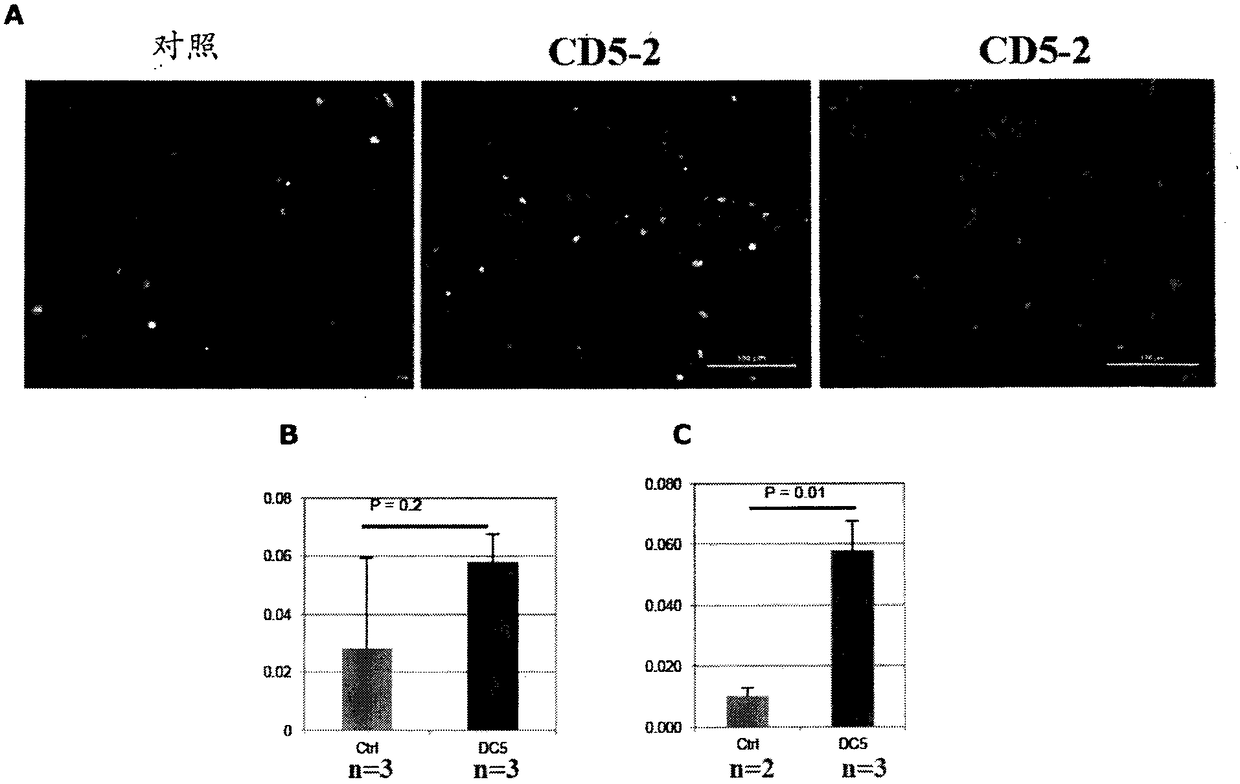Methods for treating tumours
A tumor and immunotherapy technology, applied in anti-tumor drugs, biochemical equipment and methods, pharmaceutical formulations, etc., can solve problems such as difficulty in effective delivery, unsustainable normalization of blood vessels, and damage to tumor blood vessels.
- Summary
- Abstract
- Description
- Claims
- Application Information
AI Technical Summary
Problems solved by technology
Method used
Image
Examples
example 1
[0148] Example 1-CD5-2 promotes the infiltration of CD8+ T cells into tumors and induces tumor cell apoptosis
[0149] At 27 weeks of age, RIP1-TAG5 mice were injected with control Blockmir or Blockmir CD5-2. Then 2 days later, the mice were injected with Tag-specific activated CD8+ T cells and sacrificed an additional 12 days later. Infiltration of CD8+ T cells was determined by immunofluorescence staining for CD8. Compared with the control Blockmir ( figure 1 ) injection, mice injected with CD5-2 displayed an increased ratio of infiltrating T cells (relative to cells in the field of view), suggesting that Blockmir CD5-2 promotes tumor infiltration through adoptively transferred T cells. Therefore CD5-2 can modulate the tumor microenvironment to increase the sensitivity of solid tumors to immune responses.
[0150] In another model, the B16F10 melanoma model, endogenous T cell infiltration into the middle of the tumor parenchyma was increased in Blockmir CD5-2-treated mice...
example 2
[0153] Example 2 - Blockmir CD5-2 regulates tumor vasculature and tumor vascular cell morphology
[0154] Tumor vasculature in mice bearing B16F10 melanoma was visualized using immunohistochemistry for CD31. Compared to control Blockmir-treated mice, mice treated with Blockmir CD5-2 6 to 8 days before sacrifice showed smaller blood vessels within tumors. Although the number of blood vessels per field of view was higher in Blockmir CD5-2-treated mice than in control Blockmir-treated mice, receiving Blockmir CD5-2 ( image 3 ) mice showed a significant reduction in mean vessel volume, suggesting that Blockmir CD5-2 can alter the morphology of tumor vasculature without vascular pruning. Consistent with this, CD5-2-treated EC in vitro showed no changes in angiogenesis-related features, including proliferation (data not shown), senescence (data not shown), and migration (data not shown).
[0155] Figure 4 Scanning electron microscopy approach demonstrating blood vessels within ...
example 3
[0158] Example 3 - Tumor Vasculature Function Altered by Blockmir CD5-2
[0159] In addition to altering the structure of tumor vasculature, Blockmir CD5-2 modulates the permeability and perfusion of tumor vasculature in the Bl 6F10 mouse melanoma model. Figure 8 Demonstrates extravasation of R50 fluorescent microspheres injected into control Blockmir or Blockmir CD5-2 treated mice. CD5-2 reduces vascular permeability as measured by the number of R50 fluorescent microspheres within the tumor parenchyma ( Figure 8 A). as shown in Figure 8 In B, the ratio of microspheres to endothelial markers (CD31 ) was significantly reduced in Blockmir CD5-2-treated animals relative to controls, indicating reduced leakage of Blockmir CD5-2-treated blood vessels. Consistent with this reduced vascular permeability, there was reduced deposition of fibrinogen into the stroma ( Figure 8 C and 8D).
[0160] In addition, compared to the control Blockmir treatment ( Figure 9 ), as demonstr...
PUM
 Login to View More
Login to View More Abstract
Description
Claims
Application Information
 Login to View More
Login to View More - R&D
- Intellectual Property
- Life Sciences
- Materials
- Tech Scout
- Unparalleled Data Quality
- Higher Quality Content
- 60% Fewer Hallucinations
Browse by: Latest US Patents, China's latest patents, Technical Efficacy Thesaurus, Application Domain, Technology Topic, Popular Technical Reports.
© 2025 PatSnap. All rights reserved.Legal|Privacy policy|Modern Slavery Act Transparency Statement|Sitemap|About US| Contact US: help@patsnap.com



